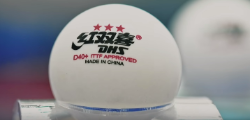You may have noticed a change to how our table tennis balls are labelled, new terms like “ABS” and “40+” now adorn the packaging. But what do they mean?
Quick History of Table Tennis Balls
Table tennis balls prior to 1900 were mainly made of rubber or cork. In 1900, a 38mm celluloid ball was introduced to England for the first time and from that time up until 2000, this style of table tennis ball was used throughout the world. In 2000, the International Table Tennis Federation ("ITTF") changed the size of the ball to 40mm, in order to slow down the game to become more television friendly. In 2014, the ITTF made the use of plastic balls legal for competition use. Manufacturers quickly saw the writing on the wall and switched over to plastic rather than celluloid balls.
Why Plastic balls over Celluloid?
The ITTF decided to start emphasising the plastic table tennis balls for a couple of reasons. Firstly, Celluloid as a material was harder to justify, both due to its relative scarcity and because it is deemed more dangerous than plastic as it is flammable. Secondly, the ITTF thought the introduction of the plastic ball would slow the game down more and lead to longer rallies.
When the plastic balls first appeared, they were mainly made from “Cellulose Acetate”, which had durability problems with frequent breakages. Recently a newer material has come on to the market called ABS (acrylonitrile butadiene styrene) which is much more durable and has a bounce much more similar to the old celluloid ball. So you will see ABS labelled on the packaging to let you know that the plastic balls are made from the better material.
Why 40+?
The reason the balls are labelled with 40+ is that when the ITTF made the plastic balls legal for competition, they also allowed the balls to have a bigger size tolerance. So a celluloid ball tends to be around 39.6mm whereas the new plastic balls measure around 40.2mm, making the plastic balls about 0.5mm bigger. The celluloid balls were labelled 40mm so the plastic ones took on 40+ as their label.
Does the change in material make a difference?
In a general sense the plastic balls are a little bit slower than their celluloid counterparts because of the increase in size. The plastic balls will also spin less because the plastic material is harder than celluloid. For competition level balls we have the DHS D40+ balls available, and in alignment with the shift to the plastic balls at an international level, we have also moved all our Alliance balls both at the training and recreational levels to ABS plastic 40+ balls.
Check out our full range of table tennis balls, and other table tennis gear.





















